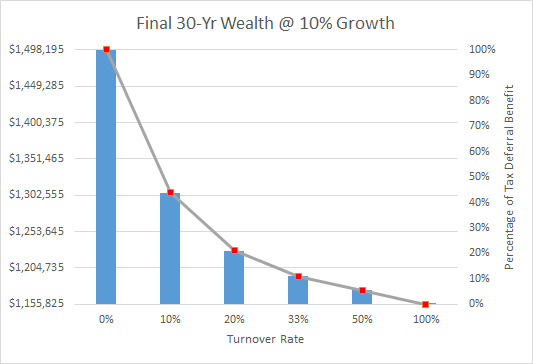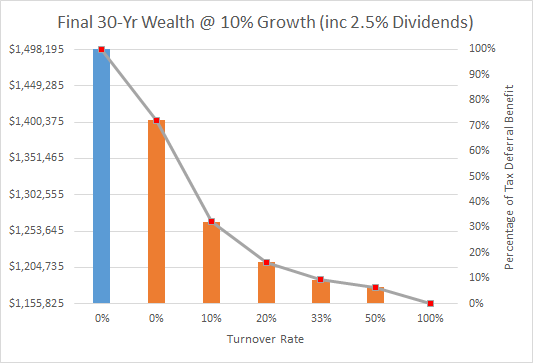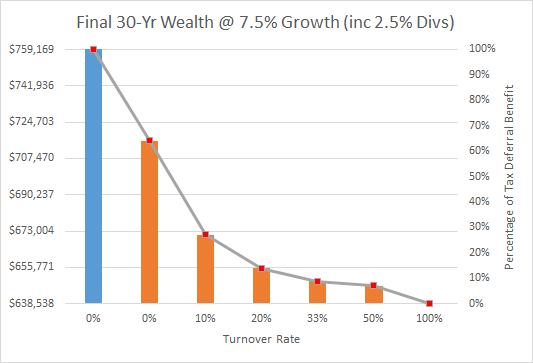Executive Summary
The basic benefit of tax deferral on investment growth is relatively straightforward: by not paying taxes, money that would have otherwise gone to the government instead can remain invested for future growth. To the extent the money will ever be spent, the taxes must eventually be paid, but as long as additional growth can be generated in the meantime, that is a value for the investor. As a result, investors often focus on deferring capital gains, and reducing the rate of portfolio turnover.
Yet a deeper look at the actual economic value of tax deferral reveals that most of the benefit is actually lost with even low levels of turnover. An investment that changes just once a decade actually forfeits more than half of the tax deferral benefits over the span of 30 years, and for a portfolio with dividends as well, a mere 10% turnover forfeits more than 2/3rds of the tax deferral value. In a lower return environment, the true tax deferral benefit of extending the average holding period of an investment from 2 years to 5 years - chopping the portfolio turnover rate from 50% down to 20% - is actually less than 5 basis points, which can be made up in the blink of an eye through a lower cost investment change or a mere day's worth of relative returns (not to mention weeks, months, or years)!
In turn, these results suggest that in the end, investors may be grossly underestimating the damage that's done by having any portfolio turnover, and grossly overestimating the value of trying to add several years to the average holding period of an investment. Of course, high turnover investing has other costs as well, and the results don't necessarily mean that rapid trading will be fruitful. Nonetheless, the limited value of tax deferral even for an investor with a decade-long average holding period suggests that investors should be highly cautious not to sacrifice prudent investment decisions upon the altar of low-turnover tax efficiency, and that it may even be time to reconsider asset location decisions and whether equities should be held in tax-deferred accounts instead.
The Impact Of Turnover On Tax Deferral
In the ideal world, a portfolio that is being invested for 30 years can actually be bought and held for the entire time horizon (0% turnover). An investor with a $100,000 stock would, assuming a 10% appreciation rate on equities for the long run, see the investment grow to a whopping $1,744,940. Assuming a 15% long-term capital gains rate on the appreciation of $1,644,940, a total of $246,741 of taxes would be due, and the after-tax value at the end of the time horizon would be $1,498,199. By contrast, if the investment's growth was taxed annually - a 100% turnover rate that results in an effective growth rate of only 8.5%/year - the after-tax value in 30 years would be $1,155,825. Thus, in essence, the "value" of tax deferral would be $342,374, which is the difference between the two scenarios. Maximizing tax deferral with 0% turnover results in a whopping 29.6% increase in wealth over the scenario with 100% turnover.
Of course, realistically most investors will likely have some amount of turnover in the range between 0% (never) and 100% (full recognition of gains every year). Accordingly, the chart below graphs the final wealth of not only 0% and 100% turnover, but also a range of other portfolio turnover rates, including 10% (every 10 years), 20% (every 5 years), 33% (every 3 years), and 50% (every other year). As indicated from the examples above, the 0% turnover portfolio results in final wealth of nearly $1.5M, the 100% turnover ends with after-tax wealth of about $1.15M, and the rest of the turnover scenarios fall in between.

Yet notably, the results reveal that the introduction of a mere 10% turnover rate actually accounts for more than half of the decline in final wealth from 0% to 100% turnover! In other words, over 50% of the "benefit" of tax deferral (the difference between the 0% and 100% turnover scenarios) is lost simply as a result of 10% turnover. The difference between 10% and 20% turnover accounts for more than half of the remaining gap as well. If we view the benefits of tax deferral as the difference between no turnover (0%) and full annual turnover (100%), it turns out that the difference between the 20% turnover and 100% turnover portfolios actually accounts for a mere 21% of the tax deferral benefit!
Or viewed another way, the 100% turnover portfolio grows at an annual rate of 8.5% (the gross of 10% minus a 15% tax drag), while the final wealth of the 0% turnover portfolio (with tax deferral benefits) is equal to 9.4%; the benefit of tax deferral was 0.9%/year of annualized return for 30 years. However, this 0.9%/year benefit of tax deferral drops to 0.44% with the introduction of "just" 10% turnover, and drops to 0.22% with 20% annual turnover. By contrast, a concerted effort to reduce portfolio turnover from 100% to 33% would result in a tax-deferral benefit of only 0.11% of annualized growth!
How Dividends Further Reduce Tax Deferral
Of course, a major caveat to the scenario above is that it assumes the stock that is held pays no dividends whatsoever. While this may conceivably be true for certain high-growth stocks, ostensibly most investors will hold a more broadly diversified portfolio (or an index fund outright), which means a portion of ongoing growth will be attributable to dividends, not just capital gains. While dividends can be reinvested over the long run, the caveat to the payment of dividends is that they are taxable immediately. Thus, in essence, an investment that pays ongoing dividends in lieu of simply appreciating grows somewhat more slowly, as the dividends that are paid are taxed before they can be reinvested, not unlike turning over capital gains (and given current qualified dividend treatment, taxed similar to long-term capital gains as well).
Yet as noted in the chart above, any level of portfolio turnover that triggers taxation of ongoing growth - including in the form of stocks that pay ongoing dividends - reduces the pace of tax-deferred growth. Even with a portfolio that will otherwise be held without any sale for 30 years, the mere fact that growth is a combination of a 2.5% dividend and 7.5% annual appreciation (where dividends are taxed annually by growth is not taxed until the end) reduces the final after-tax account value to only $1,402,622. By contrast, the fully tax-deferred account was worth $1,498,199, a difference of $95,577.
Accordingly, the chart below shows again the results of a 0% turnover (and 0% dividend) portfolio (worth $1,498,199 at the end), and a 100% turnover portfolio (worth $1,155,825 at the end) as blue bars (same as above), along with a range of portfolios in orange that include a 2.5% annual dividend and the remainder taxed at the indicated turnover rate.

As the results show in this case, the impact of even a modest rate of ongoing dividends is significant. More than 25% of the loss in the value of tax deferral benefits (the difference between the 0% no dividend and 100% turnover portfolios) is attributable to the mere presence of the 2.5% dividend. When including a 10% turnover rate, more than 2/3rds of the "damage" has already been done. A portfolio with a 2.5% dividend and 20% turnover has already foregone almost 85% of the entire benefit of tax deferral! Or stated in the context of the 0.9%/year of annualized growth benefit of tax deferral over the 30 year time horizon, the benefit drops to only 0.7%/year due to the presence of dividends, and a mere 0.33% with dividends and a 10% turnover rate. Or viewed another way, reducing turnover from 100% (annual) to 10% (once a decade) still only accrues a benefit of 0.33%/year of additional growth even after 30 years!
And of course, part of the benefit attributable to the tax deferral shown above is a result of what some consider to be a "generous" historical market return. If the dividend rate remains 2.5% but the appreciation rate is trimmed to only 5% (implying an expected equity total return of 7.5%/year in the future), the chart below is the result.

In this scenario, the total wealth is reduced (lower growth rate), as is the benefit of tax deferral is reduced in the first place (with less growth, there's less value to deferred taxation); the difference in wealth between 100% and 0% turnover is only 0.6%/year of annualized growth after 30 years. In addition, the consequences of even just a modest dividend and a small amount of turnover are even more severe. The presence of the dividend alone results in a loss of more than 1/3rd of the entire value of tax deferral, and the inclusion of a mere 10% turnover rate results in a loss of almost 3/4th of the entire tax deferral benefit; or viewed from the opposite end, once we include a mere 10% turnover and a 2.5% dividend, the entire value of tax deferral (over just having 100% turnover) is no more than 0.18% of annualized growth after 30 years, and only accounts for about 1/4th of the tax deferral benefits in the first place!
The table below provides a full summary of the results.
| Turnover | ||||||||
|---|---|---|---|---|---|---|---|---|
| No Dividend | With Dividends | |||||||
| 0% | 0% | 10% | 20% | 33% | 50% | 100% | ||
| 10% Growth Rate | ||||||||
| Final Wealth | $1,498,199 | $1,402,622 | $1,266,457 | $1,211,735 | $1,188,338 | $1,177,833 | $1,155,825 | |
| Annualized Return | 9.4% | 9.2% | 8.8% | 8.7% | 8.6% | 8.6% | 8.5% | |
| Tax Deferral Value | 0.94% | 0.70% | 0.33% | 0.17% | 0.10% | 0.07% | N/A | |
| Benefit Reduction | N/A | 25.5% | 64.9% | 81.9% | 89.3% | 92.8% | 100.0% | |
| 7.5% Growth Rate | ||||||||
| Final Wealth | $759,171 | $715,902 | $671,267 | $655,398 | $649,256 | $647,082 | $638,539 | |
| Annualized Return | 7.0% | 6.8% | 6.6% | 6.5% | 6.4% | 6.4% | 6.4% | |
| Tax Deferral Value | 0.62% | 0.41% | 0.18% | 0.09% | 0.06% | 0.05% | N/A | |
| Benefit Reduction | N/A | 34.0% | 71.2% | 85.0% | 90.4% | 92.3% | 100.0% | |
Practical Implications For Investors: Low Turnover Is Overrated?
The practical implications of these results are significant: notwithstanding common wisdom, there is remarkably little value to reducing portfolio turnover, unless it can be reduced all the way to zero. The presence of even the most modest of turnover - a portfolio that is changed but once a decade - forfeits over half the benefit of tax deferral, reduced even further by the presence of dividends, and further still in an environment with lower returns. Similarly, the benefit of shifting from 50% turnover to 20% turnover - normally considered quite significant, as that would increase the average holding period of an investment from 2 years to 5 years(!) - is no more than 10 basis points of annualized growth over a multi-decade time horizon. By contrast, a 10bps difference could be made up by one day's worth of relative return improvement by making an investment change, and even just switching to a similar investment with a lower expense ratio every few years can more than recover the entire benefit of tax deferral in the first place!
The significance of the tax drag of any level of turnover also potentially impacts decisions like asset location as well. Given how limited the value of tax-deferral actually is for a relatively low turnover dividend-paying portfolio, the results suggest that equities perhaps deserve a greater weighting towards tax-deferred retirement accounts than is commonly acknowledged, as the real benefits of tax deferral in a brokerage account are limited. If the tax deferral period is long enough - and returns are high enough - the benefits of equity tax deferral can even overwhelm the fact that the gains are "converted" to ordinary income, especially given that the benefits of asset locating bonds in a tax-deferred account are even more limited given today's low bond yields.
The bottom line, though, is simply this: unless equity investments will truly be held indefinitely with 0% turnover... and have little or no ongoing dividends... the true economic value of tax deferral for a low-but-not-zero turnover portfolio is quite limited. In turn, this suggests that investors should be highly cautious not to sacrifice prudent investment decisions upon the altar of low-turnover tax efficiency, as even the slightest differences in cost or relative return can easily trump the tax deferral benefit itself (though obviously, racking up transaction costs is still a return drag, and converting long-term capital gains into short-term gains has additional adverse effects. Nonetheless, the next time you're weighing the benefits of tax deferral against a prospective investment change, think twice about whether it's really worthwhile to try to defer those capital gains out to the future if there's a legitimate investment reason to make a change now. In this situation, the tax tail wagging the investment dog is unlikely to be worth it, as the real value of deferring capital gains is actually far less than most people think.





I know of someone who bought 50 shares of IBM in 1957 and sold it in two weeks with a 15 percent short term capital gain. How’s that for making the wrong investment decision. What are those 50 shares worth today?
It depends on what he reinvested it into. Maybe he’s worse off. Maybe he’s better off if he continued to grow his money 15% every two weeks. 🙂
But I think it’s safe to say that trying to avoid the capital gains bill (or not) wasn’t the deciding factor, which is the point of this article.
Invest in what you’re going to invest in for investment purposes. Don’t just hold it because you’re trying to dodge taxes for a year or few.
– Michael
I don’t see what are your assumptions for tax rates.
In real life, a high-turnover portfolio will have portion of cap gains taxed at the almost twice as much short term cap gains rate, which steepens the difference between the low turnover (mostly long term cap gains taxed at 23.8%) and the high turnover (mostly short term cap gains taxed at 43.4%). Was this taken into consideration?
MikeB,
The capital gains assumption is stated at 15% in the paragraph that leads up to the first chart.
Certainly, converting long-term capital gains to SHORT term – which is basically turnover rates OVER 100% – is certainly adverse here. But the discussion is about turnover rates varying from 0% to 100%, not greater-than-100%-turnover that leads to multiple intra-year trades (which is a separate discussion unto itself).
– Michael
Hi Michael – Thanks for this interesting discussion and data. Low turnover is one component of portfolio tax management that is generally combined with systematic loss-harvesting. Of course, market volatility and Uncle Sam continuously hand out capital loss carryforwards to investors who harvest low hanging tax fruits. I realize the benefit of loss harvesting is hard to model because it does not provide a linear framework. Instead, it varies according to each investor’s timeframe. For instance, investors with low turnover portfolios who harvested losses in 2008-2009 may not pay capital-gain taxes at all for decades—or maybe their lifetime. Those who joined the market past March 2009 face a different situation.
Although hard to quantify, it’s fair to assume that, over the long-run, loss harvesting significantly enhances the benefits of low turnover investment strategies. In other words, loss harvesting stretches out the benefits of low turnover. Also, considering volatility and loss harvesting will influence the asset location decision in favor of volatility in taxable accounts. This said, a stable or depleting portfolio’s opportunities for loss harvesting decrease and disappear over time… as investment values hopefully increase beyond volatility’s ability to create tax losses. This is different for a portfolio continuously investing new money (pre-retirement). A colleague keeps loss harvesting opportunities coming by using margin purchases… but that’s a different story.
JL,
Strictly speaking, systematic loss harvesting is actually LESS valuable with lower turnover portfolios, for the simple reason that without much turnover there aren’t many gains to which the losses (especially loss carryforwards) can be applied. In the logical extreme – a 0% turnover portfolio – harvesting losses is basically useless, as there are no gains to apply them against, and both the gains (and carryforward losses) will expire at death anyway!
Assuming there are at least SOME gains (and turnover to produce them), harvested losses can potentially be used to create value. The value is “something”, though as I’ve shown separately is actually not all “that” significant and is often overstated (see http://www.kitces.com/blog/wealthfront-tax-loss-harvesting-white-paper-how-not-to-calculate-tax-alpha/ ).
But the bottom line is that ironically, loss harvesting doesn’t necessarily do a lot for low turnover portfolios, because there may not be many gains against which the losses can apply (and carryforward losses basically have no value until there’s actually a gain to absorb them). Loss harvesting is actually more likely to be utilized in a timely manner with higher turnover portfolios (not to specifically advocate FOR higher turnover just to create gains, as that doesn’t help either; just pointing out that higher turnover increases the likelihood harvested losses can be used in the first place!).
– Michael
Wow!! Thanks for pointing out your previous loss-harvesting post. I can’t believe I missed that one. That’s terrific!
Michael, thanks for sharing another great post! How is the final wealth calculated for portfolios with dividends and turnover? Thanks for your help!
Vip Investment Club – 100% Hourly For 72 Hours
Vip Investment Club is a long term high yield private program, backed up by Forex market trading and investing in various funds and activities. Profits from thaese investments are used to enhance our program and increase its stability for the long term.
Invest Here
http://www.vipinvestment.net
Investment Insurance
http://www.payinghyiponline.com/vipinvestment.html
Kudos for this very informative article.Great article about tax
Michael,
Isn’t a 15% tax rate understating the deferral value?
Also, what was your assumption for tax accounting as it pertains to cost basis of the turnover?
For example, in the 10% turnover case if you do LIFO (which you could by doing tax lot accounting for cost basis) you would always have just to tax lots:
-At the end of the first year you would sell 10% of the initial investment generating a refreshed basis on that sale (new lot).
-At the end of year two you would sell again the refreshed lot and pay just for a 10% gain (as opposed to paying for a 21% gain if you did LIFO and sold all of the oldest lot).
You would keep doing this until year 30 so you would always have to sell a minor portion of the oldest lot, but the impact should be minimal.
If I am not flawed in my thinking, under LIFO you would actually end up with roughly 9.1% (90% times the no turnover rate of annualized rate of 9.2% plus 10% of the 100% turnover rate of 8.5%). That would imply 30bps more thant the 8.8% you display.
Am I right in this?